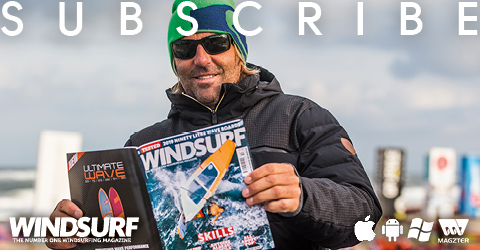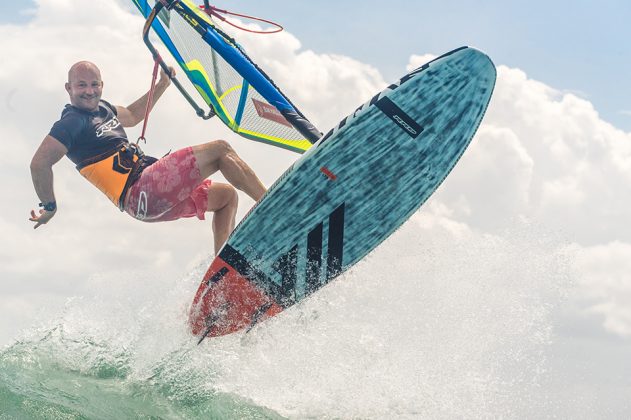JEM HALL
MOVE ON UP – WINDSURFING TECHNIQUE
ONE-HANDED JUMPS
This month we look at letting go in order to boost and enjoy our jumps even more. One-handed jumps will really improve your regular jumps and they also feel awesome.
With Jem Hall // Photos Nicolas Jones
www.jemhall.com
(This feature originally appeared in the June 2019 issue of Windsurf Magazine. To read more features like this first, Print and Digital subscriptions are available.
THE BASICS
Letting go of the boom, with one or both hands, has the benefit that it encourages us to keep low; position the rig and our body / hips / legs correctly; get away from the rig; sheet the sail in or out correctly and position our hands more precisely on the boom. It also massively helps us to take a more risk taking mindset, which is crucial to moving forward in our jumps and wavesailing. When one of my rippers does not let go of the boom, it tells me a lot about not only their skills, but also their mindset! I will present this move with the formula of who, what, why, where, when and how. And also present the options you have of what to do with your hands.
WHO: This is for both people who are early in their jumping career and experienced ‘airtimers’. Intermediate freeriders who are aspiring to be wavesailors should know that doing your recommended ‘Hall’s homework’ of one-handed blasting / sailing is already putting you in the position to be able to enjoy your one handed jumps in the future.
WHAT: The one handed jump is the releasing of either hand just as you take off, or even just before. It will improve your hooked in jumping, which is an important skill and one to be undertaken after properly learning and improving your jumping in the more physical, and safer guise of being unhooked.
WHY: There are really so many reasons to do these jumps, but the main one I discovered after feedback from one of my female wave rippers, Patricia Herrero, is that you cannot do them taking off into the wind! Jumping into the wind is an absolute killer for most ‘normal’ jumps and is one of the top malpractices that I have to coach out of people.
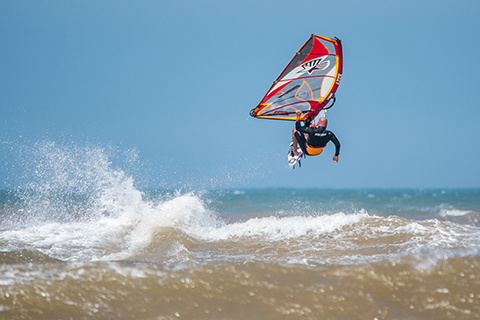
Dropping your front hand improves rig trim, body positioning, toe pointing and leg scissoring / steering.
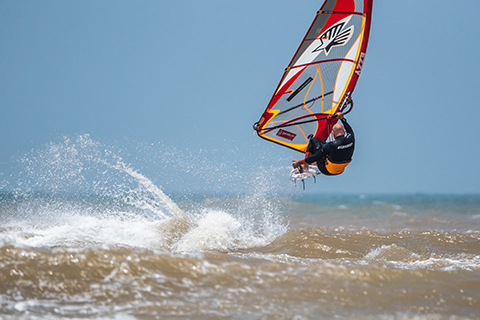
Dropping your back hand for a tail grab improves take off angle, rig positioning, back leg lifting & bending.
Here are a few more reasons to let go:
• The main one is that it is fun and really feels great.
• It can actually can get you higher in some conditions as you put more effort in and refine some key techniques, like pointing your toes, lifting your tail and it really gets you to pull the rig back and open the sail.
• The fact that you have to sheet the sail out more in the air means you land in a better shape too.
• You get a huge sense of achievement from pulling off a new move and sailing at a more competent level.
• The learning process is also fun as you go from a quick ‘fly swat’ wave and then gradually progress to letting your arm just hang down as you enjoy the freedom of flight.
• On a more technical note, as you are concentrating so hard to get the board up and ensure the rig does not catapult you, it instinctively improve your aerial leg scissoring / steering.
• Lastly, tail grabs set you up for learning to forward loop faster and dropping the front hand comfortably then means these forwards can progress to one-handed forwards.
WHERE: This is a matter of preference, but I suggest, as with many of the scarier moves, to do it early in your run, more to the inside, to get it out of the way so to speak and also to do it off less threatening and not so steep ramps.
WHEN: Just as you leave the ramp is good, but it can be done even earlier. If your jump is bigger and you have plenty of control in the air, then you can drop your hand as you reach the apex.
HOW: This whole feature describes many of the key actions. However, I feel it is best to just DO IT! This is why I coach so many one-handed moves as it encourages us to be more free thinking and let our ‘action brains’ take over. I am learning to one-handed frontside aerial, it is not pretty, and I just have a few key focus points, but in the main I just go for as many as I can off any suitable lips I can find.
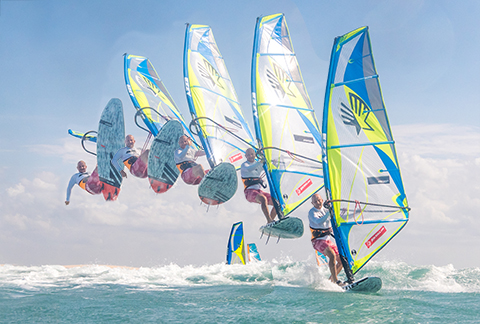
Front hand off and back on.
I drop my hand on the way up so I can be relaxed at the apex and sheet sail out by pushing out on my back hand. My legs steer the nose off the wind and front leg pressure drops the nose to get the board flat in the air. Floating down I have time to put the hand back on, ready to land tail first, sheeted out and slightly off the wind.
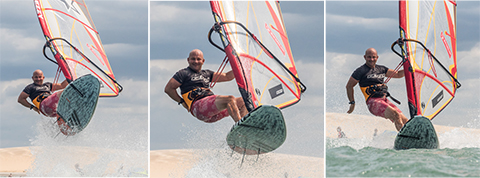
Front hand off and leave it off.
Hand comes off so I can be in position at the apex. Windward rail up which helps me steer off the wind in the air and glide.
If I keep sheeted out and spot my landing well I can keep the hand off and anticipate when to land. My back leg stays bent as long as possible so I land smooth and keep the tail upwind. My hips stay back, ready to resist the load on landing.
Prior to landing the back leg extends to land just off the wind and slightly tail first. The hand can stay off IF I have remained sheeted out. With good skills you can plane out of this one handed. DO IT!
HAND CHOICES
Letting go of either hand, or even both hands, and then what you actually do with your hands all have different relative benefits. Let’s look at the options.
Front hand off:
• Ensures you sheet out with the backhand, to avoid the dreaded nose drop!
• Ensures you get outboard to be in a position to steer the board.
• Makes you scissor (steer) the board off the wind in the air thereby making your legs more active.
• Steering off the wind gives more glide (time) to get your hand off, and back on, and will lead to a softer landing.
• With all this time to steer you will also feel the benefit and actually put into place the action of pointing your toes to lift the rail and get the wind under the board.|
• Will subconsciously get you to lift your tail so as to have a better shape / stance in the air.
• Leads you to be better at landing your jumps with all of the above factors facilitating this.
• It feels fun, free and great!
Back hand off / tail grabs:
• Again this makes you take off more across the wind, as going into the wind will simply not make the grab possible!
• Ensures you get your body outboards to have the space to lift your tail up.
• Makes you have to pull in on your front arm to move the rig back, which lifts the nose of the board for better flight time.
• Having the rig further back will also position it more across you, which helps in-flight control and landing.
• Gets you really compact in the air.
• Really gets you to understand the mechanics and benefits of lifting your tail in the air.
• Makes your tail up action more automatic and instinctive, which both boosts your jumps and helps you learn to forward loop faster, and safer!
• It feels rad and fun!
Both hands off:
• Now we are talking, this is all about belief and is the ultimate letting go.
• Gets you embracing the impossible is nothing mindset.
• Makes you realise that a lot of moves are easier than you think and that our limits can be somewhat defined by ourselves.
Rail grabs:
• This boosts all your jumping skills and makes you really understand how bigger (generous sized) footstraps help you control the board in the air.
• Being able to actually grab the rail gets you pointing your toes in the air and developing this all-important skill.
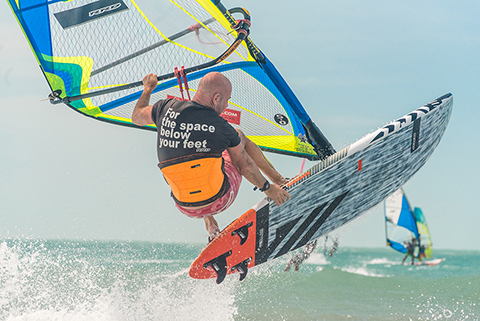
Rail grabs ensure you get compact & really gets you to point your toes down and raise the rail.
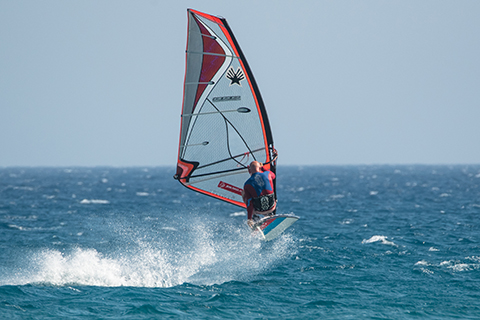
Tail grab jumps off flat water actually get you higher as you have to pull the tail up so much.
Conditions
Side to side-on wind and small to medium sized waves that are not too steep. This gives you the confidence to try these moves and ensures you do not have to take off into the wind.
Medium powered up so you feel happy releasing a hand. If you are in chop / swell, look for kickers that pop up and hopefully with the wind moving to a more favourable angle for an easier (less into the wind) take off.
“ One-handed jumps will really improve your regular jumps.”
KIT
Generous straps to allow popping off your toes and dropping the upwind rail through toe pressure.
Long lines enable you to be distanced from the rig and have more control and choices when one-handed.
On bigger boards ensure you are not overfinned as this messes with smooth popping.
RRD boards, wetsuits & soft wear, Ezzy Sails & Black Project fins sponsor Jem Hall. Get him live and direct on one of his highly acclaimed coaching holidays but be quick as they are selling out – check out his website www.jemhall.com for details. You can also follow him on twitter / Facebook / Instagram.
www.jemhall.com
